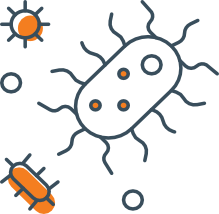Sepsis
The cause of 1 in 5 deaths worldwide

Sepsis is defined as a life-threatening organ dysfunction caused by the body’s toxic response to infection. In some cases, it can progress to septic shock, which has a mortality rate of 40%.
A blood culture is the main way to check for the microbial agent (bacteria or fungi) causing the infection and will allow to diagnose the bacteremia or fungemia as well as determine the sensitivity of these microorganisms to antibiotics and antifungals.
The speed at which appropriate treatment can be administered, based on the type of infection, determines the survival of the patient.
SepsisKey Figures

50 milion
This is the number of sepsis cases each year in the world. A WHO report called for global action against this health emergency in 2020.

40%
40% of cases concern children under the age of 5.

n°1
Sepsis is the number 1 cause of
- hospital deaths
- re-hospitalization
- health care costs

x2
In France, 30 000 deaths are a result of sepsis each year. With the growing aging population, this number could double within the next 50 years.
A Race AgainstTime!
Every hour saved is an additional chance of survival for the infected patient.
Despite major advances in the last twenty years in understanding the pathophysiology of sepsis, no therapeutic revolution has yet seen the light of day. It is therefore in the diagnostic phase where progress can be made.
Reducing the time to receive the results of the identification of the pathogen and its resistance profile will ensure a more rapid implementation or adaptation of a suitable anti-infective treatment.
Exisiting identification methods, based on the molecular detection of the main pathogens and some of their resistance genes, are expensive and non-exhaustive. MALDI/TOF mass spectrometry technology has shortened the identification phase but does not provide any prediction of resistance. The rapid antibiogram from a positive blood culture vial takes several hours of incubation before validation and most of the technologies used are expensive.
There is therefore an urgent need for a resistance identification and determination tool that is rapid, more comprehensive than current methods and economically sustainable.
WHO calls on the global community (...) to develop rapid, affordable and appropriate diagnostic tools, especially for primary and secondary health care with the aim of improving identification, surveillance, prevention and treatment of sepsis.
OMS - Press Release - September 8 2020



